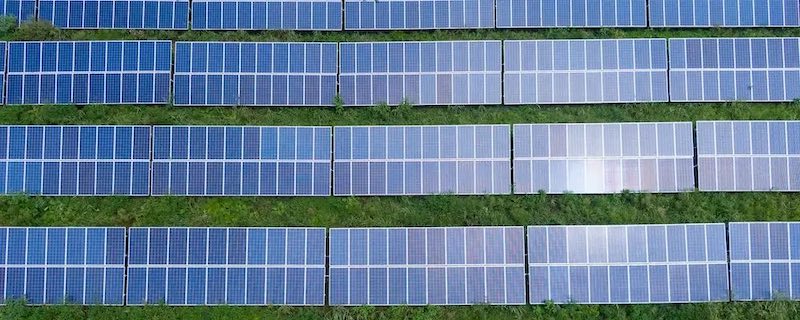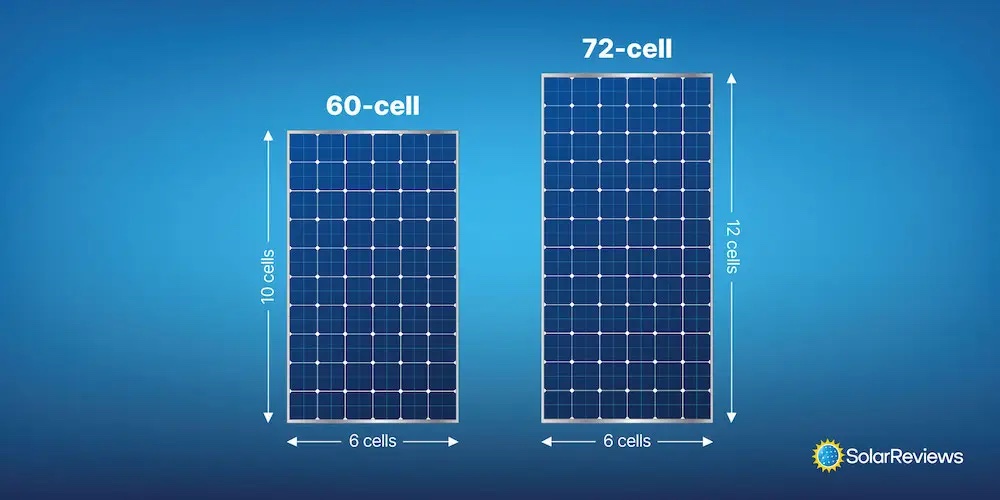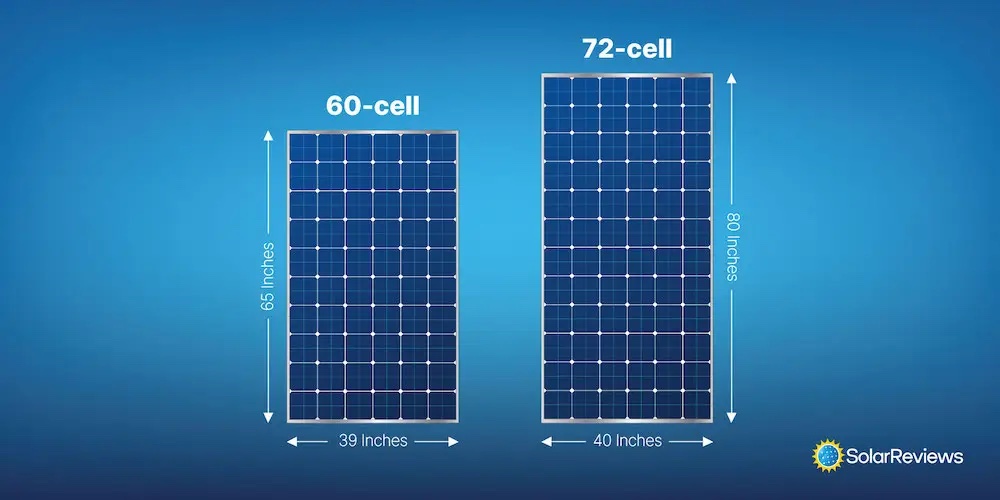Updated 11 months ago
Complete guide to solar panel size
Written by
Ana Almerini

Find out what solar panels cost in your area
If you're looking to switch to solar, you may wonder if you have enough space to install the panels. This is a valid concern - solar panels are pretty big! Most home solar panels are about 5.5 feet x 3 feet and weigh roughly 40 pounds each.
Most of the time, you won't see the size of solar panels expressed in feet. Instead, you'll see it's listed as the number of solar cells within a panel, with the most common solar panel sizes being 60-cell and 72-cell.
Let's take a closer look at the difference between these solar panel sizes and how to pick the right one for your home.
Key takeaways
-
The number of cells within a panel dictates its size - 60-cell and 72-cell panels are the most common solar panel sizes.
-
60-cell solar panels are the standard solar panel size for homes. They are usually 5.5 feet by 3 feet and weigh around 40 pounds.
-
72- cell panels are bigger, measuring around 6.5 feet by 3 feet, weigh about 50 pounds, and are typically considered commercial solar panels.
-
An average solar panel system requires between 15 to 19 solar panels and takes up 260 to 340 square feet of space.
-
Solar panel efficiency, output, a good warranty, and a trusted brand are more important than focusing on solar panel size.
How to measure solar panel size

Residential solar panels usually hold 60 cells, while larger 72-cell panels are used for commercial installations.
When you look at a solar panel, you’ll see it’s made up of small squares. Those squares are called solar cells, and they're the part of the panels that turn sunlight into electricity.
You'll see the size of a solar panel described by how many cells it has. 60-cell panels are usually laid out in a 6 by 10 grid and are the most popular option for home solar installations. You’ll typically find that 60-cell solar panels have output ratings between 350 and 400 watts and efficiency ratings between 17% and 19%.
72-cell panels, on the other hand, are usually arranged in a 6-cell by 12-cell grid. Because 72-cell panels hold more cells, they are bigger and can produce more solar power, making them popular for commercial installations. 72-cell panel wattage usually sits around 415 to 450 watts, but they can get into the 460-watt range. Their efficiency ratings are typically between 18% and 21%.
Half-cut solar cells. You may see some solar panels that have 120 cells or 144 cells. These are made using half-cut solar cells, which maximize how much of the panels’ surface can turn sunlight into electricity. Panels with 120 half-cut cells are effectively the same size as 60-cell panels. In contrast, 144-cell panels are similar to 72-cell panels.
Solar panel dimensions and weight

60-cell panels are generally around 65 inches x 39 inches. In comparison, 72-cell panels are a bit larger, at about 80 inches by 40 inches.
Many people want to know the physical size of solar panels, not just how many cells the hold. The average 60-cell solar panel is about 65 inches by 39 inches, or 5.4 feet by 3.25 feet, and weighs around 40 to 50 pounds. The actual dimensions will vary from panel to panel, so we’ve listed a few for some of the most popular 60-cell panels on the market:
60-cell panel brand | Dimensions | Weight |
|---|---|---|
64.96 x 39.02 x 1.57 inches | 40.13 lbs | |
65.7 x 39.4 x 1.26 inches | 41.45 lbs | |
65.3 × 39.1 × 0.236 inches | 51.8 lbs | |
65.55 x 39.45 x 1.38 inches | 41.9 lbs |
72-cell panels are larger, about 80 inches by 40 inches and about 1.5 inches tall. This works out to just about 6.5 feet by 3 feet for 72 cell panels, give or take a few inches. 72-cell modules generally weigh around 50 pounds. Here are the dimensions for 72-cell panels offered by top brands:
Brand | Size 72 cell panel | Weight 72 cell panel |
|---|---|---|
82.44x 40.86 x 1.38 inches | 51.80 kg | |
79.33 x 39.37 x 1.38 inches | 52.71 lbs | |
77.2 x 39.1 x 1.57 inches | 49.6 lbs | |
79.06 x 39.45 x 1.57 inches | 49.6 lbs |
Are solar panels too heavy for my roof? A solar photovoltaic system can add over 700 pounds to your roof! Most roofs can withstand solar panel weight. But, if you have an old roof, consider replacing it before installing solar. It may also be a good idea to hire a professional for an inspection if you have an older home.
Pros and cons of 60-cell and 72-cell solar panels
Here’s a brief breakdown of the pros and cons of each panel size.
Panel | Pros | Cons |
|---|---|---|
60-cell | More compact, can fit on smaller roof segments, harder to damage | Less output per panel (on average), installation requires more panels |
72-cell | More output per panel, cheaper cost per watt | Larger size means it doesn't fit well on smaller roof segments, heavier and harder to install |
How much solar do you need to install? Based on the average home's energy usage and sun exposure, most homes need 15 to 19 solar panels or a system size of between 6 kW and 7.6 kW. This requires between 260 and 340 square feet of roof space. The actual number of panels needed for your home depends on your energy usage, the sunlight you get, and the panels you choose. This solar calculator takes these factors into account to give you a more accurate estimate of the panels you need to power your home.
How big are portable solar panels?
Once solar panels are installed on your roof, you don’t have to think much about their size anymore.
But, with portable off-grid panels, solar panel size is one of the most important things to consider. Your RV might only have a small amount of roof space, or you might want something you can carry around and set up outside your campsite!
Because portable solar panels are made for travel, they tend to be smaller and have about 40 cells as opposed to 60. 200-watt portable panels are around 5 feet by 2 feet.
You could also opt for flexible solar panels, which also measure about 5 feet by 2 feet. But flexible panels can bend and are much thinner than crystalline panels, so they’re easier for storage.
The flexible panel sold by Renogy, a popular portable solar brand, has 72 cells, but they’re smaller than the ones used in typical commercial panels. The panel is also substantially lighter, weighing just 10.8 pounds!
Folding solar panel kits are also an option for portable use. Foldable panels can be small enough to fit in your backpack, or large enough to power your RV - there's a wide range of options out there.
Factors that are more important than solar panel size
There are many factors that you should consider before the size of your solar panels, like solar panel efficiency and solar panel warranties.
Solar panel efficiency
Solar panel efficiency is the percentage of light that strikes the surface of a panel that is converted into usable electricity. Modern solar panels have efficiencies that range from around 17% up to 22.8% in some premium models.
Highly efficient panels take up less space, which will allow you to fit more panels on your roof.
Solar panel warranties
There are two types of warranties that cover solar panels.
The first is the product warranty. This is the period during which you can ask the manufacturer to replace the solar panel should any problem arise. Nowadays, a product warranty of 12 years is standard, but more brands are starting to offer product warranties of 25 years.
The second type of warranty is a performance guarantee. Most mainstream panels have a 25-year production warranty, guaranteeing the panel will produce a certain level of output at every stage of the panel’s life. From the date your panels are installed up until the 25-year mark, the minimum guaranteed output of your panels will gradually decrease.
You can expect an output of close to 100% for year one, gradually down to between 80 and 92 percent for year 25. This loss in output is technically known as solar panel degradation. Some solar panel manufacturers, such as Canadian Solar, even offer a 30-year performance warranty on certain panel models.
How to find the best solar panel size
The easiest way for homeowners to figure out the best solar panel size for their needs is to work with a dedicated solar installer. Solar installers will size your system based on your energy needs, coupled with your available roof space and the sunlight in your area. They can recommend a system size that can fit on your roof and reduce or eliminate your electric bill.
For portable panels that will be drilled into an RV or need to fit on a boat, measuring where these panels can fit is important. But for a residential solar array, rest assured that your installer will get the right-sized panels for your space and energy requirements. You can find an installer in your area through the SolarReviews savings calculator to get one step closer to adding renewable energy to your roof.
Ana is the Marketing & Communications Manager at SolarReviews, working within the solar industry since 2020. With a Master's in Climate and Society and professional experience in marketing, she helps communicate the value of solar to homeowners and build awareness of the SolarReviews brand. On weekends you can find her at the Jersey shore, reading a book from the ever-increasing stack on her side table, or eating food someone else cooked....
Learn more about Ana Almerini